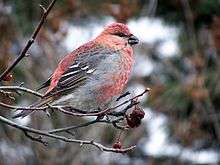Pinicola
| Pinicola | |
|---|---|
 | |
| Adult male pine grosbeak (Pinicola enucleator) | |
| Scientific classification | |
| Kingdom: | Animalia |
| Phylum: | Chordata |
| Class: | Aves |
| Order: | Passeriformes |
| Suborder: | Passeri |
| Infraorder: | Passerida |
| Superfamily: | Passeroidea |
| Family: | Fringillidae |
| Genus: | Pinicola Vieillot, 1808 |
| Synonyms | |
|
Propyrrhula (but see text) | |
Pinicola is a genus of "grosbeaks" of the finch family, Fringillidae, containing a single species, the pine grosbeak (Pinicola enucleator).[1] The genus name Pinicola is from Latin pinus, "pine tree", and colere, "to dwell".[2]
The crimson-browed finch was formerly included in the genus but was moved to Carpodacus with the rosefinches based on phylogenetic analyses of mitochondrial and nuclear DNA sequences.[1][3][4] The molecular genetic studies have shown that the most closely related species to the pine grosbeak are the bullfinches in the genus Pyrrhula.[1][3]
The original description of the genus name Pinicola by the French ornithologist Louis Jean Pierre Vieillot is variously dated to 1805,[5][6] [1.12.]1807,[7][8] or 1808[9] as the year of publication. The original description was included in Vieillot’s (1807–1809) Histoire naturelle des oiseaux de l'Amérique septentrionale[10] in tome 1 on page iv (and on plate 1 figure 13 but without associated scientific name immediately on the plate for the illustrated bill). The two volumes of this very rare work were printed in 22 consecutive issues in the course of three years. According to Peterson (2002), 1808 might be the proper publication date of Pinicola. Pinicola Vieillot, 1808 (Aves, Fringillidae) makes the name Pinicola Brébisson, 1818 a junior homonym and therefore unavailable for a genus of Xyelidae (Insecta, Hymenoptera).[6][11]
References
- 1 2 3 Gill, Frank; Donsker, David (eds.). "Finches, euphonias". World Bird List Version 5.2. International Ornithologists' Union. Retrieved 5 June 2015.
- ↑ Jobling, James A. (2010). The Helm Dictionary of Scientific Bird Names. London, United Kingdom: Christopher Helm. p. 307. ISBN 978-1-4081-2501-4.
- 1 2 Zuccon, Dario; Prŷs-Jones, Robert; Rasmussen, Pamela C.; Ericson, Per G.P. (2012). "The phylogenetic relationships and generic limits of finches (Fringillidae)" (PDF). Molecular Phylogenetics and Evolution. 62 (2): 581–596. PMID 22023825. doi:10.1016/j.ympev.2011.10.002.
- ↑ Tietze, D.T.; Päckert, M.; Martens, J.; Lehmann, H.; Sun, Y.-H. (2013). "Complete phylogeny and historical biogeography of true rosefinches (Aves: Carpodacus)". Zoological Journal of the Linnean Society. 169: 215–234. doi:10.1111/zoj.12057.
- ↑ Hellmayr, C.E. (1938). "Catalogue of birds of the Americas and adjected islands in the Field Museum of Natural History. Part xi. Ploceidae, Catambylrhyncidae, Fringillidae". Field Museum of Natural History, Zoological Series. 13 (11): 1–662.
- 1 2 Blank, S.M.; Taeger, A.; Liston, A.D.; Smith, D.R.; Rasnitsyn, A.P.; Shinohara, A.; Heidemaa, M.; Viitasaari, M. (2009). "Studies toward a World Catalog of Symphyta (Hymenoptera)" (PDF). Zootaxa. 2254: 1–96.
- ↑ Browning, M.R.; Monroe, B.L. (1991). "Clarifications and corrections of the dates of issue of some publications containing descriptions of North American birds". Archives of Natural History. 18 (3): 381–405. doi:10.3366/anh.1991.18.3.381.
- ↑ Banks, R.C.; Browning, M.R. (1995). "Comments on the status of revived old names for some North American birds". The Auk. 112 (3): 633–648. JSTOR 4088679.
- ↑ Zoological Citation Sources --H in: Peterson, A. P. (2002) Zoonomen Nomenclatural data. http://www.zoonomen.net"
- ↑ Vieillot, L.P. (1807–1809). Histoire naturelle des oiseaux de l'Amérique septentrionale, contenant un grand nombre d'espèces décrites ou figurées pour la première fois, Tome 1. Paris: Chez Desray. doi:10.3931/e-rara-7221.
- ↑ Blank, S.M.; Shinohara, A.; Altenhofer, E. (2013). "The Eurasian species of Xyela (Hymenoptera, Xyelidae): taxonomy, host plants and distribution". Zootaxa. 3629 (1): 1–106. doi:10.11646/zootaxa.3629.1.1.